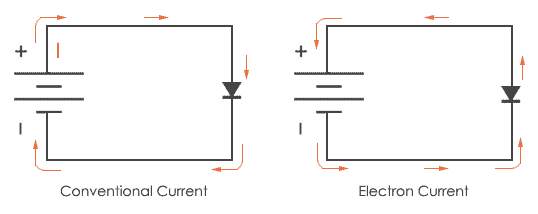Electron flow notation
Electron current and conventional current are two types of
notation we use to mention current flow in circuit. These two notations are
opposite to each other. We need a notation to do some calculations like in Kirchhoff’s
law. And we consider conventional current as the standard notation of current
flow. But actually this notation is scientifically not correct but all the laws
are followed with this notation. So before we get into these notations, we need
to understand charges.
Charges – Positive
and Negative Charges
First of all Franklin assumed an electric charge which moved
in the opposite direction that it should actually be doing, so he called this
electric charge “negative” which means deficiency of charges and so we can
consider “positive” means surplus of electric charges.
After some time, true direction of flow of electrons was
discovered and it was noticed that this labels of positive and negative is
incorrect scientifically. But by that time the notation of positive and
negative was extremely wide spread and so no efforts were made by engineers to
change the old notations. As a result of this, we are still using the same
notations that were first assumed by Sir Benjamin Franklin. And this notation
we use now is conventional current notation or normal current flow. Let’s
discuss it in detail.
Conventional Flow
Notation:
Before starting with
this, we associate the word “positive” with surplus of charges and “negative”
with deficiency of charges. This has been a label since Franklin first assumed
it.
Imagine a battery connected across the conductor. In the
electrically stressed conductor, electric charges move from positive terminal
to negative terminal of battery. Positive terminal has surplus of electric
charges and so this charges are attracted towards negative terminal of battery
where there is deficiency of charges. This notation is used widely by the
engineers and so it is said as conventional flow notation.
Electron flow
notation:
As the name itself says, this notation is based on movement
of electrons. This notation shows what actually happens inside an electrically
stressed conductor. The negative terminal of battery has high density of
electrons. This electron travels from negative terminal of battery where
density of electrons is high to positive terminal where density of electrons is
less and that’s why they get attracted towards positive terminal of battery.
Conventional flow
notation vs. Electron flow notation
This figure shows clear path of conventional current and
electron current. They are exactly opposite to each other.
Now, we know the truth that electron flow notation is
scientifically correct flow notation though we use conventional current flow
most of the time. It doesn’t matter which one you are using you can have
correct calculations while applying ohm’s law, Kirchhoff’s law and all other
equations. Most of the electronic semiconductors are designed on the basis of
conventional flow notation. For example take diode; it is like valve which
allows current to flow in only one direction. Here if higher potential is
applied to positive terminal of diode and lower potential to negative terminal
of diode, then diode will allow passing through the current because this
arrangement will break the depletion layer of diode.
And if we reverse the connections, diode will not let the
current pass through it.
After all this, you will understand what scientifically true
doesn’t matter a lot. You need to just stick to one of it, but just remember
that the electrons are moving the other direction.



Comments
Post a Comment